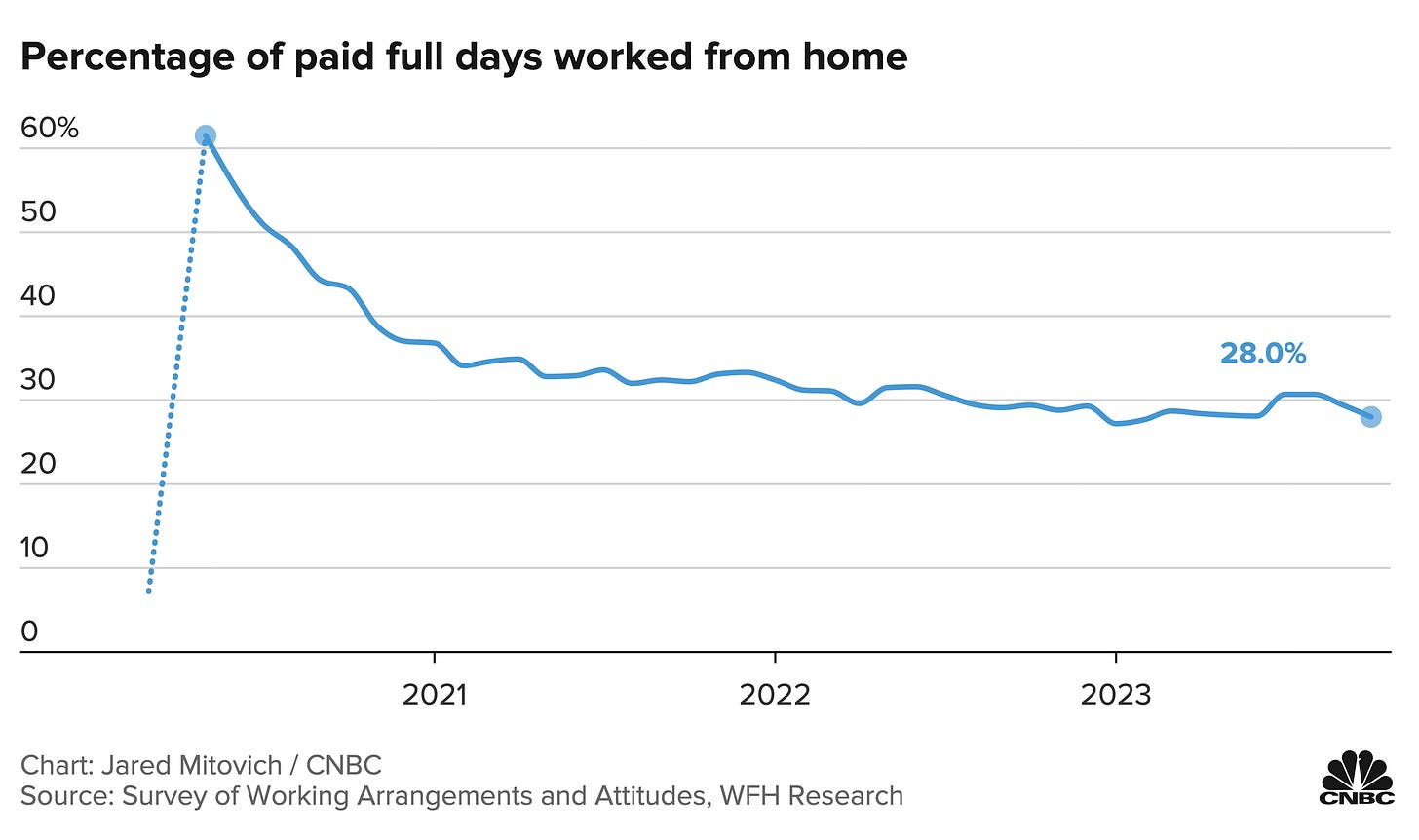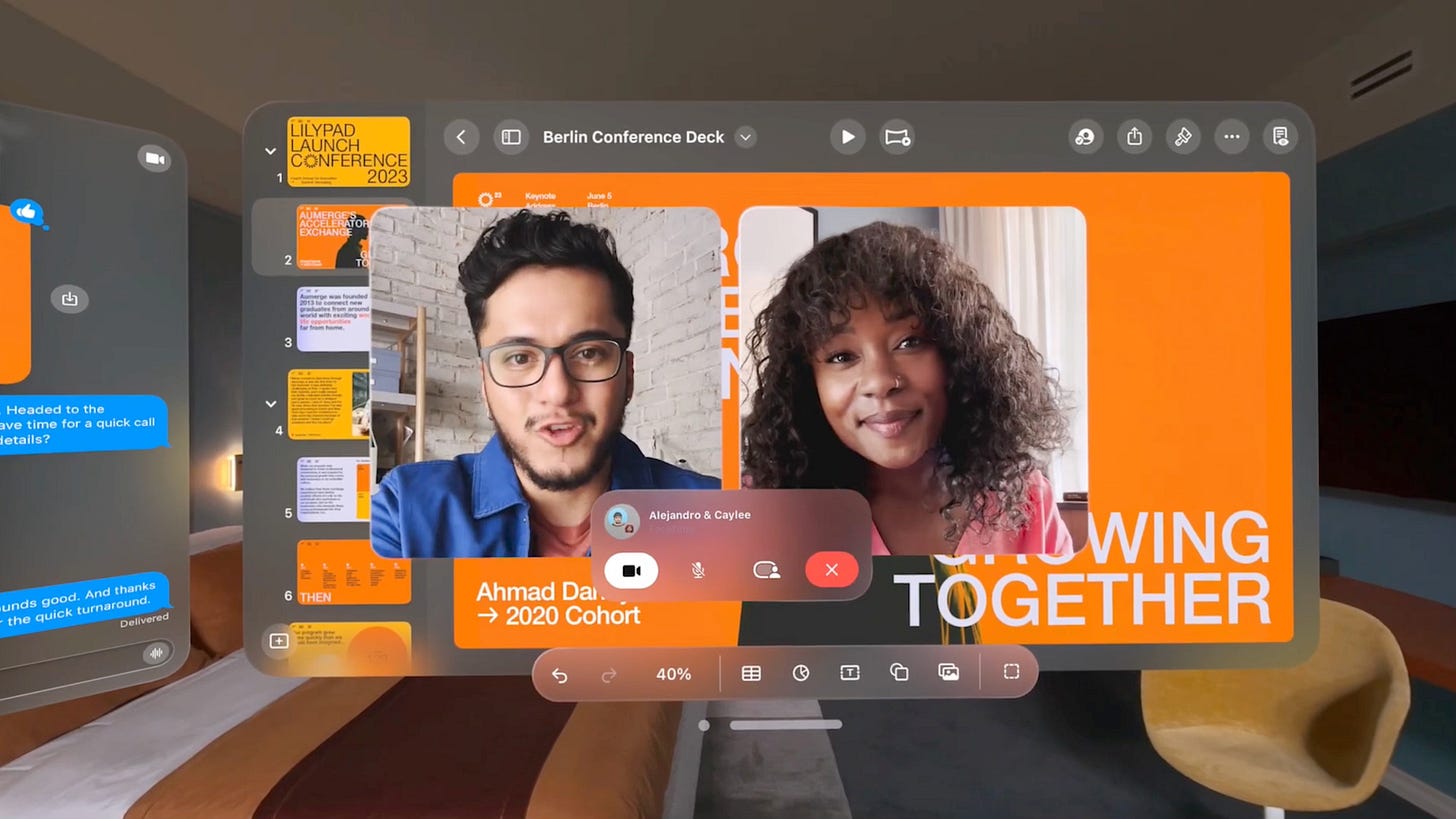Return to the Office is Dead & Apples Vision Pro
Will Spatial Computing, as Apple calls it, become the tool for remote working & fuel the work-from-home trend?
This is MadeMeThink.xyz – A Weekly Publication with Curated Content for Visionaries, Innovators & Critical Thinkers Exploring the World of Tomorrow. Written by Prof. Thomas Metzler, Ph.D.
This MadeMeThink last week…
Return to the office is dead
The Substack publication CuratedCuriosity drew my attention to an interesting article on the topic of remote work. The Stanford Economics Professor Nick Bloom says somewhat dramatically in the article "Return to the office is dead". What he means by this is that the proportion of employees being called back to the office has flatlined, but this statement would probably not have made headlines ;)
The proportion of paid work-from-home days has stabilised at 28%. Most of the remote work is done in a hybrid setting, involving a mix of days spent working from home and others in the office.
About 47% of employees who can work from home were hybrid as of October 2023, while 19% are full-time remote and 34% are fully on site” - WFH Research
In my opinion, the proportion of remote working days will increase over the next few years. In the start-up scene in particular, there is a recognisable trend in this direction. Since startups often cannot offer better salaries than the big tech players, they need to differentiate themselves as employers by offering better working conditions and in this context, remote work is the new "free snacks at the office". It seems that remote work also has a positive effect on retention.
“Employers say the biggest benefit of remote work is retention” - ZipRecruiter
Should the proportion of remote work actually increase, this could play into the hands of tech players who offer solutions in this area. I wrote an article on this back in 2022 on how extended reality & the metaverse could change the way we work (see below). So will new types of extended reality headsets become a means to an end (work from home)?
How the Metaverse could change the way we work.
The use cases made possible by the Meta Quest Pro are strongly oriented toward the workplace. This didn't surprise me, as Marc Zuckerberg already set the direction for the new devices in a conference call in the first quarter of this year.
Meta Quest Pro „… will be more focused on work use cases and eventually replacing your laptop or work setup” (Meta Q1 2022 Result Conference Call)
Last year, things became a little quieter around Meta and its Extended Reality and Metaverse plans. Nevertheless, in October 2023, Meta launched the Quest 3, a remarkable mixed reality headset for 549 euros. Last week I gave a presentation on Extended Reality in our department at the university and afterwards I had the Quest 2, Quest 3 and Quest Pro with me for the participants to test. The Quest 3 received the best feedback. It is also the headset that I often recommend to people interested in technology.
Apple Vision Pro
But now there's a new kid in town. The Apple Vision Pro can be pre-ordered from today (19 January 2024) and will be available in stores from 2 February 2024. I wrote an article about the Vision Pro back in June 2023. It's an interesting piece of technology, with even more interesting pricing: $3.499. I'm curious to see if Apple can maintain this price premium over the Quest 3. Because this price premium doesn't seem justified to me - even as an Apple user. For the time being, Apple will fuel the hype by reducing the supply.
According to one analyst, Apple will probably only produce 60,000 - 80,000 units of the Vision Pro for release (Source).
Compared to the 225 million iPhones that Apple ships every year, this is of course nothing. One of the major use cases for the Apple Vision Pro (as with the Meta Quest) is in work related settings, especially in remote settings, as can be clearly recognised from Apple's communication:
“Vision Pro is engineered to let you use your Mac seamlessly within your ideal workspace (…) makes Apple Vision Pro perfect for the office, or for when you’re working remote.“
So will Spatial Computing, as Apple calls it, become the tool for remote working and fuel the work-from-home trend? Certainly not in the short term. But as is so often the case, many observers underestimate the medium and long-term implications of such developments, as Ray Amara aptly put it:
"We tend to overestimate the effect of a technology in the short run and underestimate the effect in the long run."
Anyway, I'm already looking forward to testing the Apple Vision Pro when I get the chance. Today, my timeline is full of articles from journalists who have received the Vision Pro from Apple in advance for a one-hour test. Below you can find two passages from the articles by TechCrunch and Wired about the VisionPro test.
“In the grand scheme of things we imagine doing with mixed reality headsets, it’s not one of the sexiest. It’s work. It’s sitting at a desk typing or scrolling the internet. The rub is that there’s no desktop monitor — or rather, reality in your desktop monitor (…) As someone typing this to you while seated at a desk in front of two large monitors, the appeal is clear. (…) Is it $3,500 compelling, however? After an hour of testing I’m not fully convinced.” - Brian Heater from TechCrunch.
“I'm most excited to work in visionOS, to browse the web with a variety of virtual screens around me (…) is what attracts me the most. I would love to have the ability to open multiple windows and create a desktop-like experience in confined spaces like a coffee shop or airplane. (…) The technology is impressive, and as it progresses it will inevitably shrink so that one day, you'll just be wearing normal-looking glasses. I hope. God, I really do hope that's the direction we're going.” - Julian Chokkattu from Wired.
Both journalists emphasise the work-use case for the Vision Pro. And neither are completely satisfied with the current headset. The current Vision Pro is probably just the first step in a longer-lasting technological development that still needs many improvements to become fully mainstream.
One of the decisive factors will now be which applications companies, entrepreneurs, coders and designers create for Vision Pro. One designer has already thought ahead and sketched out what shopping could look like in the future with Vision Pro. I can't wait to see what else is in store for us.
Disclaimer: The thoughts published in this publication are my personal opinion and should not be considered as investment advice or a recommendation for any type of action. I am not a financial expert. The startups or corporates highlighted in this publication have caught my interest. This mention is not an endorsement or recommendation to engage with them. Readers should always do their own research.





